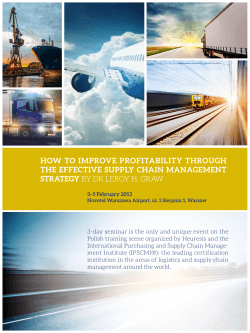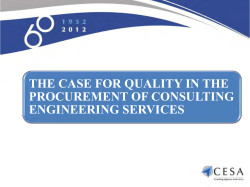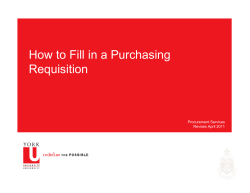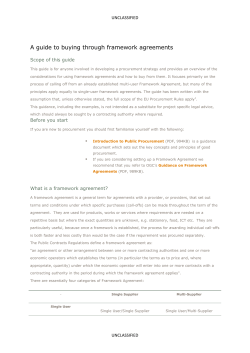
Green Procurement Guidelines
Green Procurement Guidelines An Introduction to and Benefits of Green Procurement Green Procurement involves taking into account the whole life cycle of a product, covering aspects such as the acquisition of raw materials used, the toxicity of the product or its manufacturing processes, if it contains any recycled materials, the amount of packaging used for the product, whether it is energy or water efficient, maintenance required, potential for reuse or recycling, disposal options, where it is made and if the product is supporting Fair Trade. Green Procurement is about choosing products that are less damaging to the environment and human wellbeing than the products currently being purchased. Green Procurement is not about buying the ‘greenest’ product on the market, it’s about buying ‘greener’ and finding products that suit organisational needs. Green Procurement is a method of purchasing where environmental and social considerations are taken with equal weighting to price, availability and performance. Every product purchased impacts on the environment and subsequently on human wellbeing during its life cycle. Our purchasing, usage and waste disposal choices can make a difference not only in our local community but also on a global scale. Green procurement initiatives have the potential to deliver significant market shifts towards sustainable consumption throughout Australian and international markets. Objectives and Principles of the Green Procurement Policy XXX School/ College is committed to the use and purchase of environmentally and socially responsible materials, products and services whenever they perform satisfactorily, are safe and are value for money over the lifetime of the product. Authorised purchasing officers are expected to support our commitment to environmental responsibility through the guidelines and procedures contained in this Green Procurement Policy. It is the responsibility of the purchasing officer to be aware of potential impacts that a products life cycle will have on environmental and human health and to use the school’s Green Procurement Checklist when purchasing goods, materials or services to ensure the Green Procurement Policy is met. XXX School/ College’s objective is to reduce impacts on the environment and human health through changing purchasing behaviour. By adopting a Green Procurement Policy, the school aims to: Encourage the sustainable use of resources; Reduce its impact on the environment (ecological footprint); Eliminate unnecessary purchasing; Reduce waste to landfill; Improve environmental health; Improve human health; Support sustainable long-term markets for recyclable materials; and Contribute to community progress towards sustainability. To achieve the objectives of this policy the following principles have been established, which are detailed in Appendix 1: Green Procurement Principles. a) b) c) d) e) f) g) h) i) j) k) l) m) Minimise Unnecessary Purchasing Minimise Waste Minimise Toxicity Minimise Habitat Destruction Minimise Soil Degradation Minimise Greenhouse Gas Emissions Maximise Energy Efficiency Maximise Water Efficiency Maximise Value for Money Maximise Fair Trade opportunities Maximise the Purchase of Eco- Labelled/ Environmentally Preferred Products/ Services Maximise Education for Sustainability opportunities Maximise Safety Green Procurement Guidelines The following environmental attributes should be considered desirable: Australian Produced and Made label Biodegradable Bulk purchasing Carbon Neutral Carcinogen free Chlorofluorocarbon (CFC) free Compostable Durable Endocrine disruptor free Energy Efficient- high energy star rating Environmentally Sustainable Design Fair Trade certification Forest Stewardship Council certification Free Range Farmers Association accredited Genetically Modified Organism (GMO) Free Good Environmental Choice Australia label Green Power accredited Greenhouse Friendly certified Heavy Metal free (eg. no lead, mercury) ISO 14001 compliant (or equivalent) Locally manufactured or grown Low Volatile Organic Compound (VOC) content/ off gassing Low-toxicity Lower embodied energy/ water Organic Certification Marine Stewardship Council certified Renewable materials Renewable Energy Recyclable Recycled post consumer content Recyclable consumables Recyclable packaging Reduced packaging Reduced greenhouse gas emissions Refurbished Reusable Upgradeable Water Efficient- high WELS rating Actions/ Implementation Within 6 months of policy ratification, XXX School will: nominate a staff member to co-ordinate the development and implementation of this policy establish a staff education program for the implementation of this policy eg use of checklists when purchasing goods, materials or services ensure that staff have access to information on environmentally preferred products actively promote environmental purchasing to the community require its contractors and consultants to comply with this policy Prepare an annual Action Plan for the development and implementation of the green purchasing program, identifying priorities using the risk- influence framework (or similar) on http://www.vgpb.vic.gov.au/CA256C450016850B/0/927E8CBFC93BABCECA2571E3001F77DC? OpenDocument#3 track spend of all products and services and establish % ‘green’ spend establish a system to track and report on the implementation of this policy Within 2 years of policy ramification XXX School will: review environmental, purchasing and quality criteria and develop a program to support the application of this policy review purchasing specifications, tender documentation, consultant’s briefs and contracts for compliance with this policy Green Purchase Checklist Use the Green Procurement Checklist sample (Appendix 2) or the checklist in the How to Reduce, Reuse and Recycle Waste in Schools manual (p 151) to assess whether a product or service is environmentally preferred. Also use this checklist (or an amended version) in tender documents for contract tenderers to address. Eco-Labelling Schemes in Australia and Other Useful Guides Not all green claims are the same. By appreciating the relative merit of each product you can maximise the environmental benefit of your purchasing power. Use the Eco-labelling Schemes and Other Useful Guides list (Appendix 3) to help guide procurement decisions. Green Procurement Guidelines Appendix 1: Green Procurement Objectives To achieve the objectives of this policy the following principles have been established: a) Minimise Unnecessary Purchasing Purchases must only be made once it has been determined that the product, material or service is necessary. Does the item already exist at school- check stockpiles? How many are really necessary? Avoid stockpiling/ bulk ordering products unless they are high use/ high turnover items. b) Minimise Waste Purchasing decisions must be made in the context of the waste hierarchy to: AVOID/ RETHINK Functions or tasks should be carried out without using materials that generate waste eg. send information electronically instead of on paper. Where practical and cost effective, products will be ordered in appropriate quantities to avoid having to dispose of obsolete products. Biodegradable products should be used wherever possible eg. compostable paper plates REDUCE Use less in the first place and avoid waste eg. purchase in bulk to reduce packaging, print double sided. REUSE Ensure that new purchases are durable, have a long service life and are easy to maintain, repair and upgrade. Use the same item more than once (eg cutlery, crockery) and extend the useful life of products and equipment before replacing an item. Aim to refill, re-use or repair an existing product. Borrow items from friends or other schools to avoid buying products for a one off use. Equipment purchased or rented by the school are to be compatible, whenever practicable, with the use of recycled-content or re-manufactured products (e.g. photocopy machines- recycled/ recyclable toner cartridges, recycled content paper). Obsolete items still in good working order should be given to charity or sold to extend it’s life. RECYCLE Products should contain high percentages of recycled content (>80%?) wherever possible. Paper should be purchased with at least 50% recycled content, preferably sourced from post consumer waste. Aim for best practice paper purchasing of 80-100% post consumer waste recycled paper. Choose products which can be recycled at the end of their life. Recycle goods wherever possible- investigate recycling schemes available. Some electrical goods suppliers take back products at the end of their life for recyclinginvestigate this option when purchasing equipment. DISPOSE OF WASTE THOUGHTFULLY Waste to landfill should not contain toxic or recyclable items such as batteries, fluorescent tubes, compact fluorescent lamps, computers, LCDs/ TVs, paint, chemicals, mobile phones, oil or other toxic items. Disposal schemes are available for all of these items in Victoria. c) Minimise Toxicity Products and materials should not release toxic or polluting substances that can affect human health and pollute water, land or air. Products and materials with the potential for safe, non-hazardous disposal should be chosen wherever possible. Choose biodegradable products where possible. Cleaning products should be biodegradable, low in Sodium and Phosphate (PO4), and free of carcinogens, endocrine disruptors, VOCs and scheduled poisons (S5, S6 or S7 products). Use of these products must not result in discharges of toxic chemicals to waterways at any stage of their life cycle. Green Procurement Guidelines Avoid products containing hazardous materials like Lead (Pb) or Mercury (Hg) where possible. Where hazardous materials must be purchased (eg fluorescent tubes containing Mercury), products should be used and disposed of in the most safe and environmentally friendly manner. d) Minimise Habitat Destruction Paper and wood products should be obtained from recycled, plantation, salvaged or sustainably managed Forest Stewardship Council (FSC) certified sources. Standard copy paper should be purchased with at least 30% recycled content, preferably post consumer. The higher the % recycled content the better. Virgin paper products should be Forest Stewardship Council (FSC) certified. Cleaning products should be low in Phosphate (PO4), biodegradable and free of carcinogens and endocrine disruptors. Use of these products must not result in discharges of toxic chemicals to waterways at any stage of their life cycle. Paint and other liquid wastes must be disposed of properly and must not result in discharges of toxic chemicals to waterways. e) Minimise Soil Degradation Products, materials and services should not degrade or pollute the soil, or result in erosion through their use. Organic products should be sourced wherever possible. f) Minimise Greenhouse Gas Emissions Products and materials must be energy efficient (see next principle below). Use Green Power and reduce reliance on fossil fuels. Goods and services should be sourced locally where possible g) Maximise Energy Efficiency Products and materials must be energy efficient- check the energy star rating http://www.energyrating.gov.au/ and efficiency features are the best available for the cost over the lifetime of the product. h) Maximise Water Efficiency Products and materials must be water efficient- check the water efficiency label rating http://www.waterrating.gov.au/ and efficiency features are the best available for the cost over the lifetime of the product. i) Maximise Value for Money Purchasing decisions by the school and all employees must be made on the basis of value for money rather than just the cheapest up-front purchase price. A cost benefit analysis (using the benefit: cost ratio of~ benefits/ (investment + operating costs)) may need to be undertaken on larger purchases to ascertain whether larger upfront purchase costs of materials or equipment is then offset by lower running and maintenance costs. The calculated benefit: cost ratio should be over 1. eg. Compact Fluorescent Lamps (CFL) vs Incandescent Globes (based on approximately 5.5hrs home use/ day for 4 years= ~8000 hrs) has a benefit: cost ratio of 3.46. Power (1 kWh= 1000W) Expected Lifetime Cost per kWh Operating Cost for 8,000 hrs usage (i) (cost per kWh x power (kWh) x hrs) Lamp Cost Lamp/ Globe Cost for 8,000 hrs (ii) Total Cost over 4 years/ 8,000 hrs (i+ii) Benefit (savings over 8,000 hrs) Incandescent Globe 75W (= 0.075 kWh (75/1000)) 1,000 hours $0.18 0.18 x 0.075 x 8,000 = $108 $1 $8 ($1 x 8) $116 (A) NA Compact Fluorescent Lamp 15W (= 0.015 kWh (15/1000)) 8,000 hours $0.18 0.18 x 0.015 x 8,000 = $22 $4 $4 $26 (B) A- B= 90 Green Procurement Guidelines B/C = Benefits/Cost ratio Where: B = benefits, I = investment, O = operating costs B/C ratio = B _ $90 _ $90 I+O = $4 + $22 = $26 = 3.46 B/C ratio Payback period (days) can be calculated by dividing 365 by the ratio. Usually the pay back period of a product should be during its lifetime; however a product doesn’t necessarily have to have a payback period within its life if it has a very important benefit eg addressing OH&S issues, climate change etc. eg CFL payback period based on above data: Payback Period = 365 days 365 B/C Ratio 3.46 105 days The longer the daily use of the lamp, the shorter the payback period eg if you were using the lamp for 11hrs/day then the payback period would be half (52.5 days) The school recognises that in some cases environmentally preferred products, materials or services may be more expensive than traditional sources and accordingly a price preference of 5% will be implemented under this policy to encourage purchasing of environmentally preferred products. The extra costs that may be associated with purchasing environmentally preferred products can be offset by reducing consumption of the product in the first place. eg if energy or paper consumption can be reduced, then the cost savings can respectively go towards purchasing green power or recycled content paper. Where products, materials or services that are not environmentally preferred are chosen solely on the basis of cost, the purchasing officer must detail in writing the reasons for not purchasing an environmentally preferred alternative. j) Maximise Fair Trade opportunities The purchase of Fair Trade products ensures disadvantaged farmers and workers in developing countries get better prices for their product, decent working conditions, local sustainability and fair terms of trade. Fair Trade addresses the injustices of conventional trade, and enables the poorest, weakest producers to improve their position and have more control over their lives. k) Maximise the Purchase of Eco- Labelled/ Environmentally Preferred Products/ Services Does the product achieve certification in the major eco-labelling schemes? Please see the Eco-Labelling in Australia section later in this document for guidance on labels to look for. Potential suppliers should provide details of their environmental sustainability policy/ plans/ practises. Are they ISO14001 (or equivalent) certified? Potential suppliers must meet Green Procurement Policy requirements in tender documents. l) Maximise Education for Sustainability opportunities Can the product, material or service be used in Education for Sustainability activities? m) Maximise Safety Proper MSDS (Material Safety Data Sheets) where applicable are sourced and kept on record for high risk products. Cleaning products should be pH neutral, non-irritating, and free of carcinogens, endocrine disruptors, VOCs, toxicants and scheduled poisons (S5, S6 or S7 products). Avoid products containing hazardous materials like Lead (Pb) or Mercury (Hg) wherever possible. Where hazardous materials must be purchased (eg fluorescent tubes containing Mercury), products should be used and disposed of in the most safe and environmentally friendly manner. Green Procurement Guidelines Appendix 2: Green Procurement Checklist sample This sample green procurement checklist can be used to compare a non-green product with a green purchasing alternative. Choose the criteria relevant to the item. Some criteria may not be relevant or impossible to compare so ignore this criteria. Ensure that environmental, social and financial attributes are weighted equally when making your purchasing decision. THINK BEFORE YOU BUY Is the product really needed? Yes No Can the product be borrowed from another department, school or supporter? Yes No Is there a stockpile of the product at school? Yes No DESIRABLE ATTRIBUTES- Consumables YES NO More Information Required Suitable cost (within 5% of standard product) Cost Benefit Analysis ratio greater than 1- conduct CBA when price > 5% of standard, use: benefits/ (investment + operating costs). Eg CFL compared to incandescent saves $90 over its lifetime, investment $4, lifetime operating costs $22. CBA= 90/(4 + 22)=3.46 Bulk ordering to reduce packaging- avoid stockpiling unless products are high use/ high turnover Reusable product Remanufactured/ refilled product Made from high percentage (>80%?) recycled content Paper- best practice is 80-100% post consumer waste recycled content-aim for at least 50%. If must purchase virgin fibre product, ensure FSC certified Recycling method is known/ planned for Packaging is recyclable Take back/ return of product packaging available by manufacturer eg school uniform packaging Energy and resource efficient product Organic product Criteria Not Applicable Financial Environmental Green Procurement Guidelines Product contains minimal/ no toxic chemicals: Check SASI guide for toxicity: http://www.sasiclean.com.au/product_guide.html Product contains no Lead (Pb) or Mercury (Hg) Material Safety Data Sheets (MSDS) available for high risk products eg cleaning products, chemicals Fair Trade product-tea, coffee, chocolate, balls, clothing Ecolabel certification Suitable quality- durable, long lasting Australian owned business Locally produced/ manufactured YES NO More Information Required Not Applicable Suitable cost (within 5% of standard product) Cost Benefit Analysis ratio greater than 1- conduct CBA when price > 5% of standard, use: benefits/ (investment + operating costs). Eg CFL compared to incandescent saves $90 over its lifetime, investment $4, lifetime operating costs $22. CBA=90/ (4+22)=3.46 Environmentally Sustainable Design principles used Reusable product Refurbished product Repairable product Easily maintained product Upgradeable product Packaging is minimal Extended Producer Responsibility available - removal of product (at end of life) and/ or product packaging Biodegradable product Social DESIRABLE ATTRIBUTES- Capital and Equipment Purchases Criteria Financial Environmental Green Procurement Guidelines Packaging is recyclable Product is recycled/ contains recycled content Product compatible with use of recycled and remanufactured products eg toner, paper Recycling method is known/ planned for Printers/ copiers: equipment has a duplexer for double sided printing Sleep mode or standby can be easily activated Energy efficient- high energy/ gas star rating Water efficient- high WELS rating Fuel efficient- check vehicle Fuel Consumption Label on windscreen (for vehicles under 3.5T) Product contains minimal/ no toxic chemicals: Check SASI guide for toxicity http://www.sasiclean.com.au/product_guide.html Product contains no Lead (Pb) or Mercury (Hg) Material Safety Data Sheets (MSDS) available for high risk products Ecolabel certification Suitable quality- durable, long lasting Australian owned business Locally produced/ manufactured YES NO More Information Required Not Applicable Supplier signed up to the National Packaging Covenant to reduce packaging Supplier has an internationally certified Environmental Management System (eg ISO 14000) OR supplier demonstrates commitment to environmental sustainability – environmental policy, programs, etc. Supplier has an Extended Producer Responsibility scheme Social DESIRABLE ATTRIBUTES- Supplier Criteria Green Procurement Guidelines available - removal of goods (at end of life) and/ or product packaging to ensure products are dealt with in an environmentally responsible manner eg. computers, office equipment, toner cartridges. Supplier provides Material Safety Data Sheets (MSDS) for high risk products Ecolabel certification Australian owned business Locally produced/ manufactured goods Supplier supports Fair Trade Appendix 3: Eco-Labelling Schemes in Australia and Other Useful Guides Eco-Labelling Schemes in Australia Not all green claims are the same. By appreciating the relative merit of different labels you can maximise the environmental benefit of your purchasing power. There are three types of eco-labels defined by the International Organisation for Standardisation, whose ISO 14000 series of environmental assessment methods covers environmental management, certification and eco-labelling. Type I labels (ISO 140024) are the most informative, certifying selective, multi-criteria-based, third-partycertified endorsement of a product. Type III labels (ISO 14025) certify quantified but non-selective product information based on independent verification against established benchmarks. In other words, the product meets certain standards. Type II labels (ISO 14021) are self-declared claims, such as 'dolphin-friendly'. You need to make up your own mind about the worth of such labels. (Source: Ecologic, 02/10/2008 http://www.ecologicmedia.com/index.php?option=com_content&task=view&id=34&Itemid=161) In Australia there are a number of eco-labels or certifications which you can look out for to help guide you in the purchase of goods, materials and services: Australian Certified Organic certified http://www.australianorganic.com.au/ Organic certification is when an organic certifying group audits a business’ methods to ensure that they comply with national or international standards for organic farming and processing ie any organic fruit or vegetables, crops, plants or meat products that are raised on a farm certified as organic - that is, they use no artificial fertilisers, pesticides or herbicides and no genetically-modified species. Australian Grown/ Australian Product label http://www.australianmade.com.au/productofaustralia The Australian Made, Australian Grown symbol is used on close to 10,000 products. Buying Australian Made/ Australian Grown creates jobs, boosts the economy, provides higher levels of environmental protection, reduces transportation/ food miles and improves our standard of living. Sometimes buying Australian grown isn’t always the best thing and you need to make some decisions about the whole life cycle of a product eg think carefully about buying rice grown in Australia due to its high water footprint- is it better to buy Thai or Indian rice where water is plentiful despite the length of transportation (food miles)? Australian National Packaging Covenant www.packagingcovenant.org.au The National Packaging Covenant aims to reduce environmental degradation arising from the disposal of used packaging and conserve resources through better product design and production and the reuse and recycling of used packaging materials. It is a voluntary covenant signed by the Australian and New Zealand Environment and Conservation Council Ministers, Local Government and a broad range of industries in the Green Procurement Guidelines packaging supply chain in 1999. You can check to see on the website of a company has agreed to abide by the covenant. Energy Rating http://www.energyrating.gov.au/ The Energy Rating label enables consumers to compare the energy efficiency of domestic appliances on a fair and equitable basis- the more stars the more energy efficient the product. It also provides incentive for manufacturers to improve the energy performance of appliances. Energy Star standard http://www.energystar.gov.au/ Energy Star is an international standard for energy efficient office equipment including computers, printers and photocopiers, and home electronics such as TVs, audio products and DVD players. Labelled products reduce the amount of energy consumed by either automatically switching to a 'sleep' mode when not in use and/or reducing the amount power used when in 'standby' mode. Fair Trade certification http://www.fairtrade.org.uk Products carrying the Fairtrade Certification Label are those that have been produced and sold ensuring that the third world producers, workers and communities, normally disadvantaged through current international trade rules, get a fair return for their products and labour. The Label is most commonly found on commodity products, such as coffee, chocolate and tea. Forest Stewardship Council certification http://www.fscus.org/ An international labelling scheme for forest products, which provides a credible guarantee that the product comes from a well managed forest. All forest products carrying the FSC logo have been independently certified as coming from forests that meet the internationally recognised FSC Principles and Criteria of Forest Stewardship. In this way FSC provides an incentive in the market place for good forest stewardship. Free Range Farmers Association accreditation www.freerangefarmers.com.au FRFA have an accreditation scheme which is designed to enable consumers to readily identify the product of farms that comply with the Associations published standards for free-range egg production. Such farms will have been inspected by an appointed Independent Inspector to ensure that all management practices are appropriate to the concept of free-range egg production. Additionally processes will be in place to ensure that only eggs produced on an accredited farm are sold as accredited free-range eggs. This includes an audit trail for eggs delivered and bought in from other accredited farms. Gas Rating http://www.energyrating.gov.au/gas The Gas Rating label enables consumers to compare the efficiency of gas appliances (gas space heaters and water heaters) on a fair and equitable basis- the more stars the more energy efficient the product. It also provides incentive for manufacturers to improve the performance of appliances. Good Environmental Choice Australia label www.aela.org.au The Good Environmental Choice Label is the only environmental labelling program in Australia which indicates the environmental performance of a product from a whole of product life perspective for consumer goods. The label is awarded to products that meet voluntary environmental performance standards which have been created and assessed in conformance to international environmental labelling standards. Greenhouse Friendly label http://www.climatechange.gov.au/greenhousefriendly/index.html The Greenhouse Friendly™ initiative is a concrete way for consumers to take action against global warming by purchasing greenhouse-neutral products or services, that is, products and services with zero greenhouse impacts. Green Power accreditation http://www.greenpower.gov.au/home.aspx Green Power Accredited products are renewable energy products endorsed by a collection of state governments that manage the GreenPower program. For a renewable energy product to gain endorsement from the GreenPower program it must be generated from: Eligible renewable energy sources that meet strict environmental standards; and A new renewable energy facility that was built since January 1997. (Other renewable energy exists, but it may not be accredited because it was built before 1997, and was already contributing energy to the electricity grid). Green Star Building Rating http://www.gbca.org.au/green-star/certification/ Green Star is a comprehensive, national, voluntary environmental rating scheme that evaluates the environmental design and achievements of buildings. Green Procurement Guidelines Green Vehicle Guide http://www.greenvehicleguide.gov.au The Green Vehicle Guide helps you by rating new vehicles available in Australia based on greenhouse and air pollution emissions. The rating is calculated using data provided by manufacturers from testing the vehicle against Australian standards. ISO 14001 compliance http://www.iso.org/iso/home.htm The ISO 14000 environmental management standards exist to help organizations minimize how their operations negatively affect the environment (cause adverse changes to air, water, or land) and comply with applicable laws and regulations. ISO 14001 is the international specification for an environmental management system (EMS). It specifies requirements for establishing an environmental policy, determining environmental aspects and impacts of products/activities/services, planning environmental objectives and measurable targets, implementation and operation of programs to meet objectives and targets, checking and corrective action, and management review. Source: Wikipedia Marine Stewardship Council certification http://www.msc.org/ The MSC's fishery certification program and seafood eco-label recognise and reward sustainable fishing. We are a global organisation working with fisheries, seafood companies, scientists, conservation groups and the public to promote the best environmental choice in seafood. NASSA Organic certification http://www.nasaa.com.au/ As with the Australian Organic, they use no artificial substances in farming. Also state that "humane care of animals, active soil care, pollution reduction, erosion control, shelter belts, efficient water usage and proper food handling are all part of the ethos of the organic producer." Water Efficiency Labelling Scheme http://www.waterrating.gov.au/ WELS is Australia's water efficiency labelling scheme. It allows consumers to compare the water efficiency of different products. The rating system has six stars, with the more stars the better. The labels also show a water consumption or water flow figure. Useful Guides Ecobuy www.ecobuy.org.au ECO-Buy is an award winning not for profit company that supports organisations in purchasing environmentally preferable products and operates as a Centre of Excellence in environmental purchasing Ecospecifier http://www.ecospecifier.org/ A knowledge base of over 3500 eco-products, eco-materials, technologies and resources, the leading global source of sustainable development & life-cycle assessed green product information. Energy Rating http://www.energyrating.gov.au/ The Energy Rating label enables consumers to compare the energy efficiency of domestic appliances on a fair and equitable basis- the more stars the more energy efficient the product. Search the database for information on products. Ethical Shopping Guide http://www.ethical.org.au/ The Ethical Consumer Guide gives you the low-down on the environmental and social record of companies behind common brand names. Shop with a clear conscience! Good Environmental Choice Australia label http://www.geca.org.au The Good Environmental Choice Label is the only environmental labelling program in Australia which indicates the environmental performance of a product from a whole of product life perspective for consumer goods. The label is awarded to products that meet voluntary environmental performance standards which have been created and assessed in conformance to international environmental labelling standards. Search the database for information on labelled products. Green Power Accredited http://www.greenpower.gov.au/home.aspx Green Power Accredited products are renewable energy products endorsed by a collection of state governments that manage the GreenPower program. For a renewable energy product to gain endorsement from the GreenPower program it must be generated from: Eligible renewable energy sources that meet strict environmental standards; and A new renewable energy facility that was built since January 1997. (Other renewable energy exists, but it may not be accredited because it was built before 1997, and was already contributing energy to the electricity grid). Green Procurement Guidelines True Food Guide http://www.truefood.org.au/index2.html Rating food brands by their policy on genetically engineered (GE) ingredients, this popular shopping guide is the only way to find out if foods are GE-free. Green Procurement Organisation http://www.greenprocurement.org/php/listCategories.php This database is a free resource of environmentally preferable products in Australia. The green procurement database takes a unique approach by providing meaningful and quantifiable evaluation of each product's environmental performance in addition to providing contact details and technical information about products. Green Vehicle Guide http://www.greenvehicleguide.gov.au The Green Vehicle Guide helps you by rating new vehicles available in Australia based on greenhouse and air pollution emissions. The rating is calculated using data provided by manufacturers from testing the vehicle against Australian standards. How to Reduce, Reuse and Recycle Waste in Schools http://www.sustainability.vic.gov.au/resources/documents/SV_RS_ReduceReuseRecycle.pdf This manual provides a comprehensive set of examples and ideas for use in schools. Advice is given for whole school approaches, operations, curriculum plus special tools and resources to use. SASI Cleaning Guide http://www.sasiclean.com.au/product_guide.html This guide lists all the attributes (aspects) of a cleaning product to either avoid or look for, helping you to reduce or eliminate the impacts on health, planet and water. Sustainable Seafood Guide http://www.marineconservation.org.au/default2.asp?active_page_id=137 Guide your seafood purchasing choices by finding out what seafood available in Australia is sustainably fished and managed. Planet Ark Recycling Near You Database http://www.recyclingnearyou.com.au/ Search for recycling services for anything you need to dispose of- search by council area or product. Victorian Government Purchasing Board Environmental Procurement Guidelines http://www.vgpb.vic.gov.au/CA256C450016850B/0/927E8CBFC93BABCECA2571E3001F77DC?OpenDoc ument The VGPB guidelines outline a series of processes and steps that can be taken by departments to ensure environmental factors are considered in arriving at a procurement outcome. Water Efficiency Labelling Scheme http://www.waterrating.gov.au/ WELS is Australia's water efficiency labelling scheme. It allows consumers to compare the water efficiency of different products. The rating system has six stars, with the more stars the better. Search the database for information on products. Wilderness Society Ethical Paper Guide http://www.foe.org.au/trade/media/news-items/front-page-newsfeed-1/new-guide-to-environmental-copy-paper A guide that outlines which office papers to buy, ways to reduce our paper impacts on forests and climate, and an explanation of paper brandings.
© Copyright 2025











